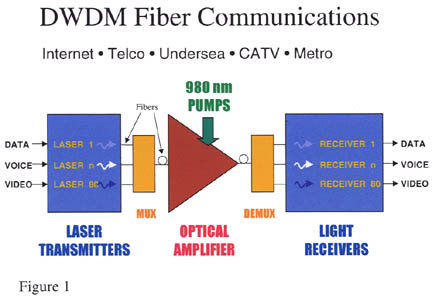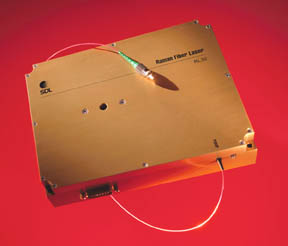Wavelength Division Multiplexing: An Optical Communication Revolution
By Donald R. Scifres
Imagine a business where user demand doubles every six months. Imagine a business that draws new users at a far faster rate than color TV, digital audio disks or VCRs. Imagine a business in which the rate of improvement in technology capability exceeds the rate of advancement in silicon integrated circuits technology over the past 25 years. This hot business is the Internet, and optical communications is the technology base that speeds the Internet information around the world.Internet information (which is doubling every six months) travels through optical fibers. Five years ago each optical fiber carried data via pulses of light at rates up to 2.5 gigabits per second. Today, fiber optic communication systems are being installed where a single fiber has the ability to carry information as much as 200 times faster than was possible just five years ago. In fact, data rates as high as 3 terabits per second have been demonstrated.
This revolutionary capability is being achieved with a technology known as wavelength division multiplexing (WDM). WDM technology relies on the fact that optical fibers can carry many wavelengths of light simultaneously without interaction between each wavelength. Thus, a single fiber can carry many separate wavelength signals or channels simultaneously. Each of these wavelength channels can be pulsed or modulated at rates of up to 10 gigabits per second (and even 40 gigabits per second or greater in experimental systems). This capacity to wavelength multiplex signals in one fiber has led to the tremendous increase in bandwidth available to power the Internet around the globe.
 Figure 1: Key components in a WDM system. |
Certain key products are required to make WDM possible (see Figure 1). The first is an optical fiber with very low loss in the wavelength range of 1530 to 1570 nm. A second key product is an erbium doped fiber amplifier (EDFA) which amplifies each of up to 100 wavelength channels identically every 100 kilometers in order to overcome the transmission loss in the optical fiber. Optical amplifiers operate based on the stimulated emission process. Each signal photon stimulates the emission of 10 to 100 or more identical photons from erbium atoms with electrons excited to a high-energy state through the absorption of photons at wavelengths of either 980 nm or 1480 nm. Due to stimulated emission, the amplified output signal matches both the wavelength and pulse shape of the input signal.
A third key product is the signal generating transmission laser. Each signal laser emits light at a single precisely defined wavelength. Each wavelength channel requires a separate signal-generating transmission laser. These are generally spaced on 100 GHz or 200 GHz spacings across the 1530 to 1570 nm gain bandwidth of the EDFAs. Up to approximately 100 wavelength channels provided by 100 distributed feedback semiconductor lasers can be used.
A fourth key product is a wavelength multiplexer. This allows the insertion of all the separate wavelength laser signals to be combined into a single fiber. Narrow band dielectric stack filters are generally used to combine the separate wavelength signals into one fiber.
At the opposite end of the system from a transmission laser, a wavelength demultiplexer (which is a mirror image of the multiplexer) separates the signals into separate wavelengths of light. Each wavelength then impinges on a fifth key product, the light receiver. Generally, the receiver (which converts each wavelength channel back into electricity) consists of a PIN photodiode or avalanche photodiode and associated high-speed electronics to interface the signal into the computer or electronic network.
 Figure 2: Shown above is a high power (1.5 W) fiber laser operating at 1455 nm. This allows amplification of 1550 nm optical signals through 20 km of standard single mode optical transmission fiber via stimulated Raman scattering (SRS). SRS amplification is expected to allow 40 Gb/sec transmission over many wavelength channels to further enhance the transmission capacity per fiber. |
All of these elements combine to send information from one point to another via fibers. However, for the purpose of redundancy, reliability, capacity and cost efficiency, optical mesh networks are now being built with the ability to route wavelength channels along multiple paths to get to their final destination. In order to accomplish this, products such as Add/Drop Multiplexers allow the insertion or separation of one or more wavelengths from the many wavelengths in the fiber. This allows WDM systems to achieve the desired mesh network topology.
Finally, optical switches that allow dynamic rerouting of separate wavelength channels are now being announced. These put in sight the final goal of a transparent fiber optical network with minimal conversion of light back into electricity. Within five years, we anticipate that light will be able to flow like electricity does today through optical switches and routers to the proper network destination. As a result, low cost, high-speed data at rates up to 1 gigabit per second may over a 10-year time frame arrive at your computer terminal with the apparent ease and cost provided by today's telephone networks.
In order to develop these advanced technologies, there are many opportunities for cutting edge jobs with plenty of intellectual challenge. Some of the challenges involve developing new methods of amplification (see Figure 2 for Raman Amplifier), higher data transmission speeds, and smaller size, lower cost modules. All this may occur through the transition from hybrid products with discrete fibers, lenses and chips to fully monolithic products that integrate these functions onto a common substrate. In this manner, applied physicists, optical scientists, and electrical engineers will enable the wavelength division multiplexing optical communications industry to grow from a $1.6 billion market in 1997 to a $12 billion market in 2005.
Dr. Donald R. Scifres is chairman, CEO and a founder of SDL, Inc., a company specializing in fiber optics and lasers for the communications, printing and materials processing industries. Dr. Scifres has been issued over 100 patents, published over 300 technical papers and has contributed to or edited several books in the field. Dr. Scifres has also won a number of industry awards including the APS George Pake Award in 1997.
©1995 - 2024, AMERICAN PHYSICAL SOCIETY
APS encourages the redistribution of the materials included in this newspaper provided that attribution to the source is noted and the materials are not truncated or changed.
Editor: Barrett H. Ripin
Associate Editor: Jennifer Ouellette
December 1999 (Volume 8, Number 11)
Articles in this Issue

